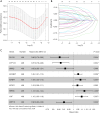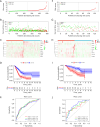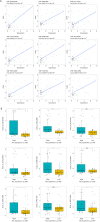Defining lung adenocarcinoma subtypes with glucocorticoid-related genes and constructing a prognostic index for immunotherapy guidance
- PMID: 40400930
- PMCID: PMC12090106
- DOI: 10.21037/jtd-24-1083
Defining lung adenocarcinoma subtypes with glucocorticoid-related genes and constructing a prognostic index for immunotherapy guidance
Abstract
Background: Several studies have shown that glucocorticoid-related genes (GCGs) play a crucial role in cancer. However, the mechanism of GCGs in lung adenocarcinoma (LUAD) is not fully understood. This study aimed to identify distinct subtypes of LUAD by integrating GCGs and to develop prognostic models for precise prognosis prediction and immunotherapy guidance.
Methods: In this study, sample data of LUAD were collected from The Cancer Genome Atlas (TCGA) database, and unsupervised clustering was used to identify LUAD subtypes with different GCGs characteristics. Survival-related genes were screened by differential expression analysis and protein-protein interaction (PPI) network analysis. After that, the least absolute shrinkage and selection operator (LASSO) combined with Cox regression analysis was used to establish the prognosis model. Differences in the immune microenvironment of different risk groups were analyzed, and Tumor Immune Dysfunction and Exclusion (TIDE) was used to predict the response of patients to immunotherapy. Finally, the CellMiner database was used to predict potential drugs.
Results: Two subtypes of LUAD were identified, namely cluster 1 (high survival rate) and cluster 2 (low survival rate). A prognostic model was constructed based on 9 characteristic genes, including CLCA1, CYP17A1, GRIA2, IGFBP1, IGF2BP1, NTSR1, RPE65, VGF, and WNT16, and the prognosis of LUAD patients was positively predicted. There were differences in the immune microenvironment of different risk LUAD patients, and high-risk LUAD patients may benefit less from immunotherapy. BGB-283 was a candidate for LUAD targeting VGF.
Conclusions: Our study elucidates the impact of GCGs on LUAD prognosis and immune responses, offering insights for prognostic forecasting and immunotherapeutic strategies for LUAD patients.
Keywords: Glucocorticoid-related genes (GCGs); immunotherapy; lung adenocarcinoma (LUAD); prognostic models; subtypes.
Copyright © 2025 AME Publishing Company. All rights reserved.
Conflict of interest statement
Conflicts of Interest: All authors have completed the ICMJE uniform disclosure form (available at https://jtd.amegroups.com/article/view/10.21037/jtd-24-1083/coif). The authors have no conflicts of interest to declare.
Figures









Similar articles
-
Identification of Lung Adenocarcinoma Subtypes Using Growth Hormone-Releasing Hormone-Related Genes and Establishment of Signature to Predict Prognosis and Guide Immunotherapy.J Environ Pathol Toxicol Oncol. 2025;44(2):13-29. doi: 10.1615/JEnvironPatholToxicolOncol.2024053370. J Environ Pathol Toxicol Oncol. 2025. PMID: 40493898
-
Identification of different lung adenocarcinoma subtypes in combination with antidiuretic hormone-related genes and creation of an associated index to predict prognosis and guide immunotherapy.Comput Biol Chem. 2025 May 15;119:108506. doi: 10.1016/j.compbiolchem.2025.108506. Online ahead of print. Comput Biol Chem. 2025. PMID: 40412340
-
Anoikis-related subtype and prognosis analyses based on bioinformatics, and an expression verification of ANGPTL4 based on experiments of lung adenocarcinoma.J Thorac Dis. 2024 Aug 31;16(8):5361-5378. doi: 10.21037/jtd-24-1123. Epub 2024 Aug 28. J Thorac Dis. 2024. PMID: 39268091 Free PMC article.
-
Leveraging diverse cell-death patterns to predict the clinical outcome of immune checkpoint therapy in lung adenocarcinoma: Based on muti-omics analysis and vitro assay.Oncol Res. 2023 Dec 28;32(2):393-407. doi: 10.32604/or.2023.031134. eCollection 2023. Oncol Res. 2023. PMID: 38186574 Free PMC article.
-
Bioinformatics analysis of an immunotherapy responsiveness-related gene signature in predicting lung adenocarcinoma prognosis.Transl Lung Cancer Res. 2024 Jun 30;13(6):1277-1295. doi: 10.21037/tlcr-24-309. Epub 2024 Jun 7. Transl Lung Cancer Res. 2024. PMID: 38973963 Free PMC article.
References
LinkOut - more resources
Full Text Sources
